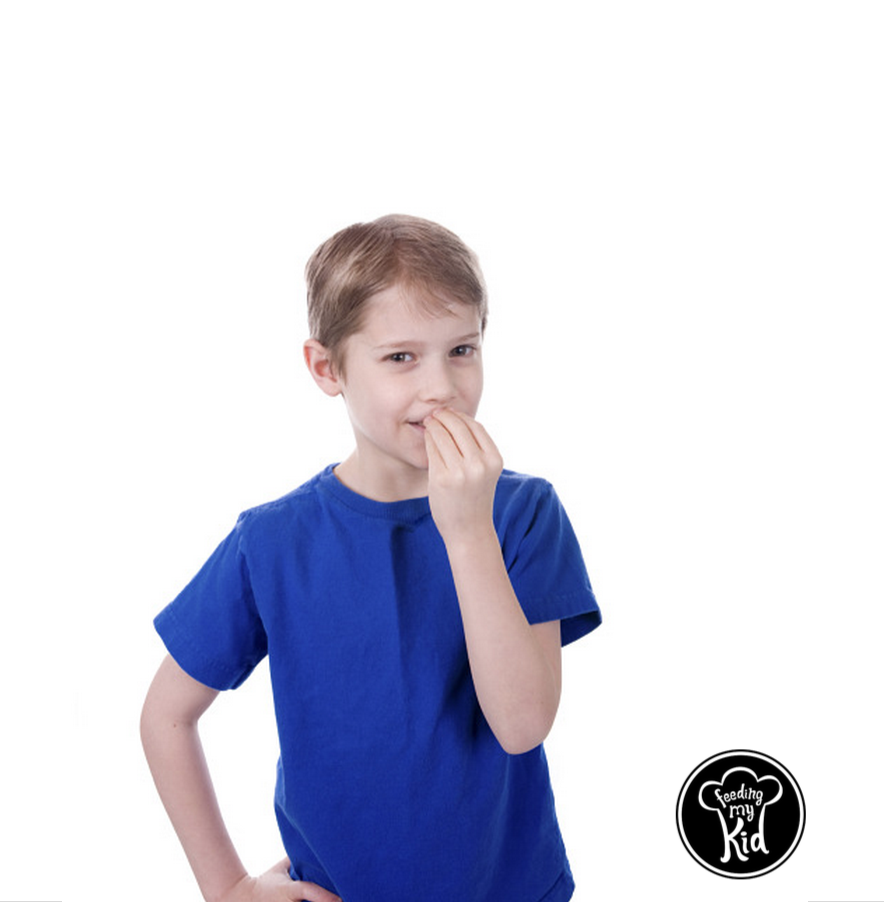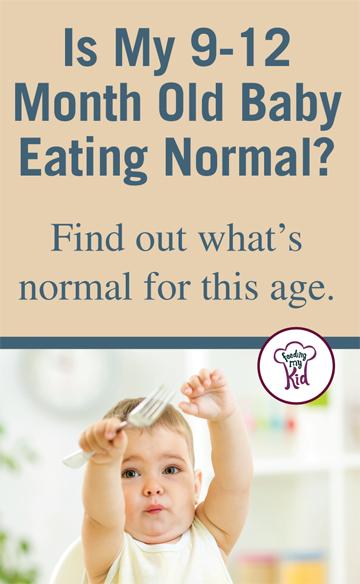 At this stage of the game, I had some concerns about how one of my twins was eating. After multiple calls to the Pediatrician, the staff kept assuring me that he’s just a picky eater and eating at this age is not important, since he get all of his needed nutrients from breastmilk and/or formula.
At this stage of the game, I had some concerns about how one of my twins was eating. After multiple calls to the Pediatrician, the staff kept assuring me that he’s just a picky eater and eating at this age is not important, since he get all of his needed nutrients from breastmilk and/or formula.
Follow Your Intuition
My mother’s intuition was telling me something else was up and I wasn’t going to just accept the Pediatrician’s answer. In the end, my son did have an issue with jaw strength and we eventually got a referral to an Occupational Therapist.
I’m going to go against the somewhat dismissive advice I received, and tell you that eating at this stage is very important! It is important to start transitioning your child from purees to solid foods.
Baby-Lead Weaning
If you did baby-lead weaning then you don’t have to transition as much as just ensuring your child is eat a larger variety of foods at this age each month. Don’t get stuck in a food rut.
Now Is the Time to Introduce Tremendous Variety into Your Child’s Diet
Why? Because babies are most open to trying new flavors and textures before 12 months, so introduce as much variety as possible to your children as early as possible, but studies caution not to offer too much solid foods before six months. Ah, but here is the conflicting advice… offer your baby lots of tastes of foods starting at 4 months of age. Check out the article to learn more about the studies.
Ah, but here is the conflicting advice… new studies now show the sweet spot for food acceptance is between 4-7 months. I definitely missed that sweet spot with my twins. If you missed it too, don’t worry! Just start now.
Offer lots and lots of variety of textures, flavors, and preparations.
Avoid Processed Foods and Sugars
Do your best to avoid processed foods and sugars. One reason so many kids are picky eaters are because of processed foods. When you buy chicken nuggets at the store they will always be uninformed, taste bland and look the exact same as every other chicken nugget. It’s reliable. When you make homemade food, it might be burned one time, misshapen the next time and so on. Homemade meals are beautifully unreliable. Your kids won’t grow to expect that everything is so uninformed and perfect like only a machine can make. Making a lot of home cooked meals is harder now, but reducing your chances of having a picky eater later will be worth the extra work. I promise.
When you make homemade food, it might be burned one time, misshapen the next time and so on. Homemade meals are beautifully unreliable. Your kids won’t grow to expect that everything is so uninformed and perfect like only a machine can make. Making a lot of home cooked meals is harder now, but reducing your chances of having a picky eater later will be worth the extra work. I promise.
Plus, processed foods can be loaded with added sugar, preservatives, chemicals, and sodium.
Beware of How Much Sodium Your Child is Having
Find out how much sodium/ salt a child should have. If you’re serving a lot of processed foods/ premade foods to your baby, toddler or child, then he or she is probably having too much sodium. Plus, if your child is eating at restaurants and places like Chick-fil-A then it’s important that you read the article about sodium so you’re more aware of how to read labels and what to look for.
Does Your Baby Have a Good Appetite?
That’s normal. Some parents are surprised by how much their baby can eat! Your child’s appetite might surprise you at this age.
However, a child’s appetite can start to taper off after 12 months, as his or her growth starts to slow down. In the first year, babies grow 300% and that slows to about 10% the next year. Again, normal. It’s important to set the right expectations.
Are you worried your baby isn’t eating enough? Check out our article, What to do if your child isn’t eating enough (under-eater).
Need 9-12 Month Mealtime Ideas
What’s a Good Feeding Schedule?
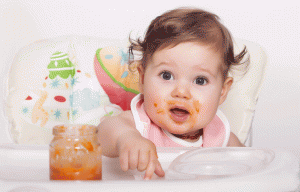 Most babies at this age drink about 4 to 5 breastmilk or formula feedings a day. Your child should have 3 solid meals a day and possibly 1-2 snacks. Most kids will need to eat every 3 to 4 hours.
Most babies at this age drink about 4 to 5 breastmilk or formula feedings a day. Your child should have 3 solid meals a day and possibly 1-2 snacks. Most kids will need to eat every 3 to 4 hours.
The amount of breastmilk or formula he drinks should be going down to about 20-28 oz a day. Your child should be drinking or breastfeeding first thing in the morning and then in-between meals. If you are breastfeeding, your milk will naturally start going down during this phase, as he will be less hungry and emptying your breast less, which pulls down your supply to match your child’s demand.
Here Is A Sample Schedule To Show The Spacing Between Breastfeeding/ Formula And Mealtimes:
6:30 am Wake Up, Breastfeed Or Formula Feed
8 am Breakfast
8:30 am Nap
10:30 am Breastfeed Or Formula Feed
12pm Lunch
2 pm Breastfeed Or Formula Feed
2 -4 pm Nap
5 pm Dinner
6 -6:30 pm Breastfeed or formula feed
Related Reading:
-
-
- Six Feeding Tips For Parents with Infants Turning Six Months
- Introducing First Foods to Your Baby: What I wish someone told me [Part 1]
- Introducing First Foods to Your Baby: What I wish someone told me [Part 2]
- Baby 4 – 7 Months: Find Out How to Shape Your Baby’s Taste Buds For a Lifetime
- Your Ultimate Guide to Introducing First Food to Your Baby
- Childhood BMI Can Predict Obesity Starting at Early as 6 Months
-
How Much Should My Child Be Eating?
 Generally, a child can eat about 1 TBSP of food in each of the main food groups per meal per year of life. So if he is 9 months, he can eat about 3 TBSP of food per meal mixed between protein, carb, fruit, dairy, and vegetable. The goal is to have them eat about 4 oz of food per meal.
Generally, a child can eat about 1 TBSP of food in each of the main food groups per meal per year of life. So if he is 9 months, he can eat about 3 TBSP of food per meal mixed between protein, carb, fruit, dairy, and vegetable. The goal is to have them eat about 4 oz of food per meal.
It is completely normal if he eats 2 TBSP or even 3 TBSP of one food group and not eat the others during a meal. Studies show that it evens out throughout the week and it is completely normal and healthy.
As the parent, just keep offering your child healthy food options with each meal. Personally, I did not offer carbs to my twins until they started slowing down on eating the protein and vegetable portion of their meal. I wouldn’t even have it on the table until it was time to serve it. My boy loves his carbs and if I present it to him at the beginning of the meal he would only eat the bread. I like to get some veggies and protein into them first.
Find out what a toddler serving size of food looks like.
What Else Should I Be Doing At This Phase?
Your child should be weaning off purees if, he hasn’t already, during this phase. Around 12 months, I started using the puree pouches again as a veggie smoothie occasionally when they were sick or when my twins were teething and their gums hurt.
Try transitioning your child from a bottle to a sippy cup during this phase. Offer your child the water in a sippy cup or regular cup during mealtimes.If your child is breastfed, start offering water in the sippy cup.
Never offer juice in a bottle.
It’s best not to offer juice, at all, at this age. Find out why it’s so important to not offer your child juice!
Let Your Child Feeding Himself
Children should be working on learning to feed themselves. It’s messy, but studies show this can reduce obesity in children as the child can better regulate the amount of food to eat versus being spoon-fed and risk overeating.
Have you heard of baby-led weaning? Learn more about it.
Check out the article are you Choo-Chooing your Way to An Overeater?
Enjoy Meals Together
Try to eat with your child and have him sit with the family at the table. You will see his eating improves when he is eating with the family. Babies mimic what their parent’s are doing, even when it comes to eating their vegetables. Start getting in the habit of modeling the eating you want your baby to do. Also, check out the article, you hate brussels sprouts, chances are your kid will too for more information about the power of modeling.
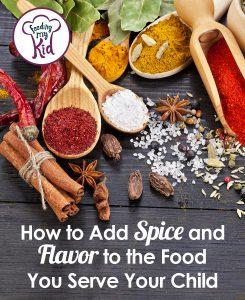 Add Flavor and Spice to Your Meals
Add Flavor and Spice to Your Meals
Be bold with your food choices and spices. Yes, it’s recommended you add lots of flavor to their food, but not the salt.
If you are spoon-feeding, make sure you let your child put his lips around the spoon and take the food off on his own. I was scraping the food off my twins’ mouths and found out later this was a no, no. Also, let your child try to feed himself with a spoon or at least hold on to a spoon while you are spoon-feeding him. It can never be too early to start practicing self-feeding.
How Long Should Feedings Take?
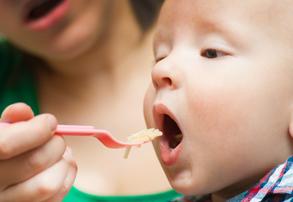 It should take about 20-30 minutes to feed your baby. If it’s taking longer, stop the meal, and then start again at the next meal. Your child will become faster over time. I’ve spoken with some moms that say it can take 2 hours to feed their child. This is counterproductive. End the meal and have fun with your baby working up an appetite for the next meal. Don’t worry he or she won’t starve.
It should take about 20-30 minutes to feed your baby. If it’s taking longer, stop the meal, and then start again at the next meal. Your child will become faster over time. I’ve spoken with some moms that say it can take 2 hours to feed their child. This is counterproductive. End the meal and have fun with your baby working up an appetite for the next meal. Don’t worry he or she won’t starve.
Skip the Mealtime Distractions
Don’t allow toys on the table while eating. Also, turn the TV off. You don’t want your child to be distracted while eating. This can later lead to him or her not learning to pay attention to their own body cues for fullness and become an overeater. This is an important habit to not start with your young child!
This is an important habit to not start with your young child!
 Let Your Child Play with Food
Let Your Child Play with Food
But, your child can and should be allowed to play with food-related items like spoons and of course his food. Food play should be encouraged. It is ok to get messy and allow your child to play with his food. The more you let your child get messy the quicker they will learn to manipulate food, spoons, forks, etc. Plus, the extra mess can help to reduce picky eating down the road.
What’s Normal For This Age?
Some kids start off a lot more hesitant with trying new foods and if you work hard on constantly introducing new foods, he will be more receptive to trying them. Again, normal. Allow your child to play with food at the table and through food sensory activities. Through constant exposure and play, a hesitant child can eventually try the food.
Find out what to do if you think your child is an under-eater.
Find out what to do if your child is an over-eater.
Don’t Fear The Face
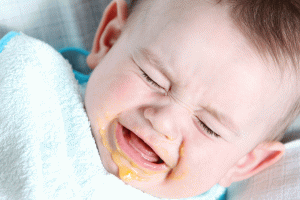 Even if your child doesn’t seem to like the food being offered at first, don’t give up! Just like you are teaching your child to use a sippy cup and eat solids, you need to teach him how to enjoy a variety of flavors and foods. Your children’s palate is still changing. Even if he make that face, change up the preparation and offer the food to him again. It can take up to 30+ tries before a child grows to appreciate and like a food. So, don’t give up! Remember, you are helping your children to develop eating habits that will last a lifetime.
Even if your child doesn’t seem to like the food being offered at first, don’t give up! Just like you are teaching your child to use a sippy cup and eat solids, you need to teach him how to enjoy a variety of flavors and foods. Your children’s palate is still changing. Even if he make that face, change up the preparation and offer the food to him again. It can take up to 30+ tries before a child grows to appreciate and like a food. So, don’t give up! Remember, you are helping your children to develop eating habits that will last a lifetime.
Some kids have a harder time with textures than others. My twins were never ok with purees that had texture in them. However, they transitioned to table foods and skipped textured purees. Try to get your children to eat as much variety of textures as they can. I wish I had known this information when I was weaning, it would have saved me so much time and effort in having to overcome my son’s texture issues.
How Do I Know When My Child Is Hungry?
Your child should be signaling that he wants to eat. If you haven’t tried teaching a few signs from sign language, the sign to eat is a great one for kids to learn.
Your child should be giving signals that he is ready for the next bite or more food. He should be leaning forward for the next bite or smiling to show you he is ready. Don’t worry if your little one doesn’t do this each time.
Your child should start letting you know when he is hungry by putting his fingers in his mouth, reaching for foods, coming towards his high chair or signaling in other ways.
How Do You Know When Your Child Is Full?
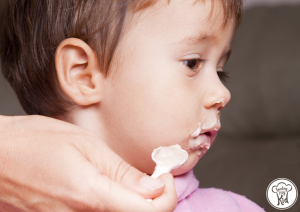 Your baby will show you he is done eating by slowing down how fast he is eating and/or by closing his mouth or turning away from the spoon or you. For more signs your baby is full. Also, if he starts playing with his food or throwing it, these can be signs he is done.
Your baby will show you he is done eating by slowing down how fast he is eating and/or by closing his mouth or turning away from the spoon or you. For more signs your baby is full. Also, if he starts playing with his food or throwing it, these can be signs he is done.
I also taught my twins the sign language sign for all done. That really helped and my twins even used the sign to tell me when they were done with the playground swings and other activities. It was a lifesaver.
Most babies will tell you when they are done. They are great at self-regulating. It’s very important to foster this satiety (fullness) feeling in children so they don’t become overeaters.
Don’t keep encouraging your child to eat after he signals he is done.
It’s Ok To Throw Food And Wear Your Meal
It’s completely normal for babies and  toddlers to throw their food and smear it all over. Kids are experiencing food using their different senses, including touch, as he rubs it all over their arms and head. And it’s a part of their sensory development, so let them roll around in it 🙂 Don’t clean your child until the meal is done, no matter how messy he gets. And, take pictures of this phase to embarrass your soon-to-be teenager with these photos.
toddlers to throw their food and smear it all over. Kids are experiencing food using their different senses, including touch, as he rubs it all over their arms and head. And it’s a part of their sensory development, so let them roll around in it 🙂 Don’t clean your child until the meal is done, no matter how messy he gets. And, take pictures of this phase to embarrass your soon-to-be teenager with these photos.
Plus, kids become familiar to food by looking at it, touching it, playing with it, putting it to their lips, tasting it and finally eating it. Yes, sometimes it takes all these steps to get your child to eat a particular food. Each step is incredibly important to getting your child to feel comfortable with the food.
If your child is covered in food, don’t clean him up until the meal is complete. Otherwise, you are denying him the chance to further experience the food. Seriously.
My Kid Doesn’t Like Food
 Some kids don’t like eating purees or being spoon-fed. Try cutting up the food in small pieces and letting them eat on their own. If the food is slippery, especially fruit and veggies, add some crushed up dry cereal to help your child grip the food.
Some kids don’t like eating purees or being spoon-fed. Try cutting up the food in small pieces and letting them eat on their own. If the food is slippery, especially fruit and veggies, add some crushed up dry cereal to help your child grip the food.
Try offering finger foods and whole foods to see he starts eating. You can also give him large pieces of food that he can pick up and take bites from, even without teeth as long as it is a softer food or steamed. Give your child a big chunk of banana or a baked carrot stick.
Also, evaluate how much formula or breastmilk your child is getting. Maybe you haven’t pulled the milk back enough thus causing him not to be hungry when you are trying to feed him solid foods. Also, try changing around your schedule to see if you can spark some interest in solid foods.
At this age, your child should be open to eating solid foods. If not, speak with your Pediatrician to see if there might be another reason your child does not want to eat, such as reflux, allergies, etc.
My Kid Doesn’t Always Eat
It’s normal for kids to eat a ton one day and not eat a lot the next. Sometimes it’s because he is not feeling well, teething, constipated and the list goes on.
Sometimes his body isn’t requiring a lot of calories because of inactivity or because his growth has slowed down.
Don’t worry! Generally, kids won’t starve themselves. If you think it’s teething, try offering cold and soft foods like yogurt to help soothe their gums. If you are concerned, call your doctor. Find out what to do if you think your child is an under-eater.
You Should Consider Seeing A Doctor, If You See These Warning Signs:
- If it looks like your child does not seem to like to eat, call your pediatrician.
- Your child does not let you know he is getting hungry. Reflect on how much snacking your child is doing throughout the day. This might prevent your child from experiencing hunger. I’m not talking about the child neglect hunger, but the hunger that happens when you haven’t eaten much in a few hours. Kids need to feel hungry to be open to trying new foods and eating a healthy size portion of dinner. Read the article on snacking to learn how to manage this.
- Does your child still nurse or get a bottle in the middle of the night? Your child might not be getting enough food during the day and needs the extra calories at night. It can also be that your child is using breastfeeding as a way to soothe. Since your child is getting calories at night, he may be less motivated to eat during the day. A child’s body is great at self-regulating.
- Is your child still gagging when eating solid foods?
- Does your child seem sensitive to different textures? He should be open to trying and eating foods with all kinds of textures at this point. Different textures include yogurt, crackers, small pieces of meat, fruit, and vegetables.
- Your child is fussy and unhappy after a meal. He acts as if his tummy hurts or he is hungry after a meal.
- He cries when you put him in his high chair and refuses food.
Some Occupational Therapists and Speech Therapists specialize in feeding challenges. By reaching out to your doctor, he or she can refer you to a feeding specialist to figure out why you are seeing these warning signs.
How do you know if you need an Occupational Therapist?
Does your child need occupational therapy?
How to find an Occupational Therapist in your area?
What Constitutes a Picky Eater?
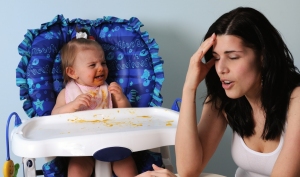 When a child only eats a limited range of foods and/or has resistance to trying new foods. There are studies that show up to 50% of all parents think they have a picky eater. You are in good company!
When a child only eats a limited range of foods and/or has resistance to trying new foods. There are studies that show up to 50% of all parents think they have a picky eater. You are in good company!
There are a lot of things we as parents can do to help our kids through this phase unscathed. There are a lot of pitfalls, so check out our Ultimate Picky Eating Resource Guide. It’s a comprehensive guide providing tons of information on how to help your picky eater become an adventurous eater. Plus, find articles on how not to turn your child into an emotional eater or overeater as an adult.
Watch our video on why kids are picky eaters.
My Child Doesn’t Have Enough Teeth To Chew Food
It’s ok if your child has 2, 4 or no teeth at this point. Children don’t need teeth as long as the food you provide them is cut up small and cooked so it’s soft. A child’s gums are strong enough to grind food. And, they need the practice to grow his or her jaw strength.
Relieving Our Own Anxiety
It is completely NORMAL for babies and toddlers to go through picky eating phases. It’s not necessarily that the child is picky eater. The child is unsure of the food. The one way to help children overcome this unfamiliarity is by exposing them to vegetables and fruits at every feeding opportunity. The more times he is exposed to a food, the more likely he is to try it and eventually love it.
What’s Next
Check out our next article in this series, what’s normal eating and feeding behaviors for 12-18 months olds. This gives you a great idea of what to expect next!
Share your thoughts.


